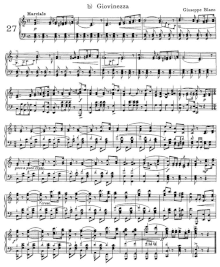Giovinezza (graduation song)
Originally widespread among students at the University of Turin, the goliardic song celebrated the end of studies and the impending assumption of adult responsibilities, resulting in the fading of the sweetness of youth.
A protagonist of the student Belle Époque, Oxilia would meet a young death during World War I on 18 November 1917, on the Monte Grappa line in Veneto, struck by shrapnel on Mount Tomba.
In the trattoria, Oxilia was in the company of his musician friend Giuseppe Blanc, who added music to the lyrics,[3] and the song met with considerable approval in Turin's goliardic circles, so much so that it was immediately printed in 150 copies by the students themselves.
According to a study published in 2013 by Patrizia Deabate,[5] the original version of the hymn was Oxilia's response to a poem written half a century earlier by the Milanese Emilio Praga, a "cursed" poet belonging to the Scapigliatura movement.
The Hymn, moreover, would have its earliest roots in the exaltation of the youth of the French Revolution, with its reference to a symbol contained in Eugène Delacroix's famous painting, Liberty Leading the People, housed in the Louvre Museum in Paris.
A thesis reiterated, with further historical and literary references, in the preface to "Canti brevi" by Nino Oxilia, in the 2014 reissue edited by Patrizia Deabate for the series directed by Roberto Rossi Precerutti, Neos Edizioni, Turin.
These were the years when, in turn-of-the-century Turin, incipient industrial development was already delineating a sociological divide; compared to the world of smokestacks and mechanics' factories, the song represented a counter-song expression of a city anchored in its Risorgimento soul, the Savoyan society "of limited but secure horizons, of life without eagerness, of the small and serene things sung with regret by Guido Gozzano.
deʎʎi ˈstuːdj e ddeʎʎ aˈmoːri o komˈpaɲɲi in ˈalto i ˈkwɔːri il pasˈsaːto saluˈtjam of studies and of love; o companions in high hearts, the past we salute.
ˈduːna ˈpikkola zdeɲˈɲoːsa ˈtrettʃe ˈbjonde ˈlabbra ˈrɔːza ˈɔkkj adˈdzurri ˈkoːme il ˈmar of a little disdainful one, blonde braids, pink lips, eyes blue like the sea.
i kreˈpuskoli verˈmiʎʎi tra lle ˈverdj ˈombre dei ˈtiʎʎi i fanˈtastitʃi vaˈɡar the vermilion twilight among the green shadows of lime trees the fantastic wanderings.


